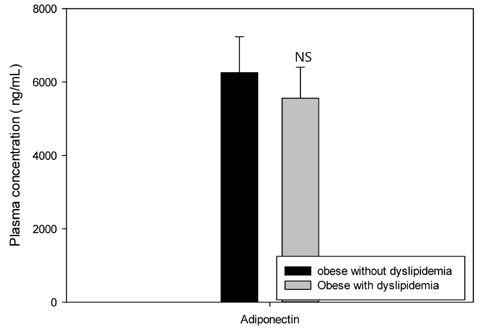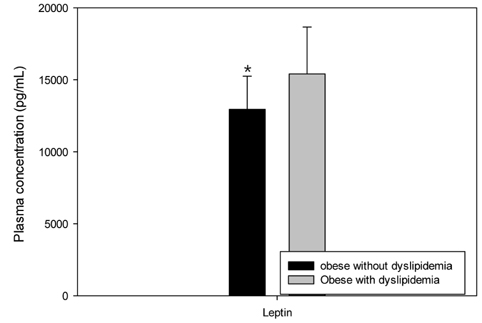Nutr Res Pract.
2014 Aug;8(4):417-424.
Plasma adipocytokines and antioxidants-status in Korean overweight and obese females with dyslipidemia
- Affiliations
-
- 1Department of Food Science and Nutrition, Dankook University, 152 Jukjeon-Ro, Suji-Gu, Yongin-Si, Gyeonggi 448-701, Korea. wkkim@dankook.ac.kr
- 2Department of Food and Nutrition, Eulji University, 553 Sanseong-Daero, Seongnam-Si, Gyeonggi 461-632, Korea.
Abstract
- BACKGROUD/OBEJECTIVES: It is hypothesized that obese people with dyslipidemia is more likely to have increased oxidative stress and decreased antioxidant status, in comparison with the controls who were obese without dyslipidemia. Thus, the aims of the present study were to determine the dietary intakes, plasma adipokines, and antioxidative systems between obese with dyslipidemia and obese without dyslipidemia were investigated.
SUBJECTS/METHODS
Female subjects who were between 20 and 55 years old, and whose BMI was 23 or greater were recruited. Subjects who met the criteria of BMI > or = 23, total cholesterol > or = 200 mg/dL, LDL cholesterol > or = 130 mg/dL, and TG > or = 110 mg/dL were categorized Obese with dyslipidemia. Anthropometric measurements and blood biochemical tests were conducted. The diet survey was conducted by a trained dietitian using two days of 24 hour dietary recall. The lipid peroxidation, the plasma total antioxidant capacity (TAC), the activities of antioxidantive enzymes, and various antioxidantive vitamins levels were determined.
RESULTS
Plasma adiponectin and leptin levels were also determined. There were no significant differences for age, Body Mass index (BMI), and body fat (%), waist-size between two groups. Obese with dyslipidemia had significantly high levels of total cholesterol, triglyceride, LDL-cholesterol, the ratio of total cholesterol/HDL-C, and the ratio of HDL-C/LDL-C, respectively. Blood alkaline phosphatase level was statistically different between the two groups (P < 0.05). No statistical significance in dietary intake between two groups was shown. In case of obese with dyslipidemia group, the levels of GSH-Px (P < 0.05) and catalase (P < 0.05) as well as adjusted blood retinol (P < 0.05) and tocopherol level (P < 0.05) were significantly low. However, the plasma concentration of leptin was significantly high (P < 0.05).
CONCLUSIONS
Obesity with dyslipidemia was shown to have high arthtrogenic index, depleted antioxidant status, and higher blood leptin levels which suggest higher risks of oxidative stress and cardiovascular diseases.
Keyword
MeSH Terms
-
Adipokines*
Adiponectin
Adipose Tissue
Alkaline Phosphatase
Body Mass Index
Cardiovascular Diseases
Catalase
Cholesterol
Cholesterol, LDL
Diet Surveys
Dyslipidemias*
Female
Humans
Leptin
Lipid Peroxidation
Nutritionists
Obesity
Overweight*
Oxidative Stress
Plasma*
Tocopherols
Triglycerides
Vitamin A
Vitamins
Adipokines
Adiponectin
Alkaline Phosphatase
Catalase
Cholesterol
Cholesterol, LDL
Leptin
Tocopherols
Vitamin A
Vitamins
Figure
Reference
-
1. Ministry of Health and Welfare. Korea Centers for Disease Control and Prevention. Korea Health Statistics 2009: Korea National Health and Nutrition Examination Survey(KNHANES IV-3). Cheongwon: Korea Centers for Disease Control and Prevent;2010.2. Calori G, Lattuada G, Piemonti L, Garancini MP, Ragogna F, Villa M, Mannino S, Crosignani P, Bosi E, Luzi L, Ruotolo G, Perseghin G. Prevalence, metabolic features, and prognosis of metabolically healthy obese Italian individuals: the Cremona Study. Diabetes Care. 2011; 34:210–215.
Article3. Song Y, Manson JE, Meigs JB, Ridker PM, Buring JE, Liu S. Comparison of usefulness of body mass index versus metabolic risk factors in predicting 10-year risk of cardiovascular events in women. Am J Cardiol. 2007; 100:1654–1658.
Article4. Hamer M, Stamatakis E. Metabolically healthy obesity and risk of all-cause and cardiovascular disease mortality. J Clin Endocrinol Metab. 2012; 97:2482–2488.
Article5. Perségol L, Vergès B, Gambert P, Duvillard L. Inability of HDL from abdominally obese subjects to counteract the inhibitory effect of oxidized LDL on vasorelaxation. J Lipid Res. 2007; 48:1396–1401.
Article6. Lima SC, Arrais RF, Almeida MG, Souza ZM, Pedrosa LF. Plasma lipid profile and lipid peroxidation in overweight or obese children and adolescents. J Pediatr (Rio J). 2004; 80:23–28.
Article7. Yang RL, Shi YH, Hao G, Li W, Le GW. Increasing oxidative stress with progressive hyperlipidemia in human: relation between malondialdehyde and atherogenic index. J Clin Biochem Nutr. 2008; 43:154–158.
Article8. Bolkent S, Yanardag R, Bolkent S, Döger MM. Beneficial effects of combined treatment with niacin and chromium on the liver of hyperlipemic rats. Biol Trace Elem Res. 2004; 101:219–229.
Article9. Kershaw EE, Flier JS. Adipose tissue as an endocrine organ. J Clin Endocrinol Metab. 2004; 89:2548–2556.
Article10. Collins S, Kuhn CM, Petro AE, Swick AG, Chrunyk BA, Surwit RS. Role of leptin in fat regulation. Nature. 1996; 380:677.
Article11. Arita Y, Kihara S, Ouchi N, Takahashi M, Maeda K, Miyagawa J, Hotta K, Shimomura I, Nakamura T, Miyaoka K, Kuriyama H, Nishida M, Yamashita S, Okubo K, Matsubara K, Muraguchi M, Ohmoto Y, Funahashi T, Matsuzawa Y. Paradoxical decrease of an adipose-specific protein, adiponectin, in obesity. Biochem Biophys Res Commun. 1999; 257:79–83.
Article12. Spiegelman BM, Flier JS. Obesity and the regulation of energy balance. Cell. 2001; 104:531–543.
Article13. Savini I, Catani MV, Evangelista D, Gasperi V, Avigliano L. Obesity-associated oxidative stress: strategies finalized to improve redox state. Int J Mol Sci. 2013; 14:10497–10538.
Article14. Valko M, Leibfritz D, Moncol J, Cronin MT, Mazur M, Telser J. Free radicals and antioxidants in normal physiological functions and human disease. Int J Biochem Cell Biol. 2007; 39:44–84.
Article15. McGee DL. Diverse Populations C. Body mass index and mortality: a meta-analysis based on person-level data from twenty-six observational studies. Ann Epidemiol. 2005; 15:87–97.
Article16. Friedewald WT, Levy RI, Fredrickson DS. Estimation of the concentration of low-density lipoprotein cholesterol in plasma, without use of the preparative ultracentrifuge. Clin Chem. 1972; 18:499–502.
Article17. Ohkawa H, Ohishi N, Yagi K. Assay for lipid peroxides in animal tissues by thiobarbituric acid reaction. Anal Biochem. 1979; 95:351–358.
Article18. Rice-Evans CA. Measurement of total antioxidant activity as a marker of antioxidant status in vivo: procedures and limitations. Free Radic Res. 2000; 33:Suppl. S59–S66.19. Aebi H. Catalase in vitro. Methods Enzymol. 1984; 105:121–126.20. Fridovich I. Superoxide radical: an endogenous toxicant. Annu Rev Pharmacol Toxicol. 1983; 23:239–257.
Article21. Paglia DE, Valentine WN. Studies on the quantitative and qualitative characterization of erythrocyte glutathione peroxidase. J Lab Clin Med. 1967; 70:158–169.22. Catignani GL, Bieri JG. Simultaneous determination of retinol and alpha-tocopherol in serum or plasma by liquid chromatography. Clin Chem. 1983; 29:708–712.
Article23. Craft NE, Brown ED, Smith JC Jr. Effects of storage and handling conditions on concentrations of individual carotenoids, retinol, and tocopherol in plasma. Clin Chem. 1988; 34:44–48.
Article24. Goh VH, Tain CF, Tong TY, Mok HP, Wong MT. Are BMI and other anthropometric measures appropriate as indices for obesity? A study in an Asian population. J Lipid Res. 2004; 45:1892–1898.
Article25. WHO Expert Consultation. Appropriate body-mass index for Asian populations and its implications for policy and intervention strategies. Lancet. 2004; 363:157–163.26. Iwao N, Iwao S, Muller DC, Koda M, Ando F, Shimokata H, Kobayashi F, Andres R. Differences in the relationship between lipid CHD risk factors and body composition in Caucasians and Japanese. Int J Obes (Lond). 2005; 29:228–235.
Article27. Shin HH. Korean guidelines of hyperlipidemia treatment for prevention of atherosclerosis. J Korean Soc Lipidol Atheroscler. 2002; 12:226–228.28. Lemieux I, Lamarche B, Couillard C, Pascot A, Cantin B, Bergeron J, Dagenais GR, Després JP. Total cholesterol/HDL cholesterol ratio vs LDL cholesterol/HDL cholesterol ratio as indices of ischemic heart disease risk in men: the Quebec Cardiovascular Study. Arch Intern Med. 2001; 161:2685–2692.
Article29. Leroux G, Lemieux I, Lamarche B, Cantin B, Dagenais GR, Lupien PJ, Després JP. Influence of triglyceride concentration on the relationship between lipoprotein cholesterol and apolipoprotein B and A-I levels. Metabolism. 2000; 49:53–61.
Article30. Pike AF, Kramer NI, Blaauboer BJ, Seinen W, Brands R. A novel hypothesis for an alkaline phosphatase 'rescue' mechanism in the hepatic acute phase immune response. Biochim Biophys Acta. 2013; 1832:2044–2056.
Article31. Ryu WS, Lee SH, Kim CK, Kim BJ, Yoon BW. Increased serum alkaline phosphatase as a predictor of long-term mortality after stroke. Neurology. 2010; 75:1995–2002.
Article32. Cook NR, Obarzanek E, Cutler JA, Buring JE, Rexrode KM, Kumanyika SK, Appel LJ, Whelton PK. Trials of Hypertension Prevention Collaborative Research Group. Joint effects of sodium and potassium intake on subsequent cardiovascular disease: the Trials of Hypertension Prevention follow-up study. Arch Intern Med. 2009; 169:32–40.
Article33. Kido M, Ando K, Onozato ML, Tojo A, Yoshikawa M, Ogita T, Fujita T. Protective effect of dietary potassium against vascular injury in salt-sensitive hypertension. Hypertension. 2008; 51:225–231.
Article34. Matsui H, Shimosawa T, Uetake Y, Wang H, Ogura S, Kaneko T, Liu J, Ando K, Fujita T. Protective effect of potassium against the hypertensive cardiac dysfunction: association with reactive oxygen species reduction. Hypertension. 2006; 48:225–231.
Article35. Okuno Y, Matsuda M, Kobayashi H, Morita K, Suzuki E, Fukuhara A, Komuro R, Shimabukuro M, Shimomura I. Adipose expression of catalase is regulated via a novel remote PPARgamma-responsive region. Biochem Biophys Res Commun. 2008; 366:698–704.
Article36. Sharma R, Sharma A. Effect of obesity on antioxidant enzymes and type 2 diabetes. Indian J Clin Biochem. 2007; 22:Suppl. 259–265.37. Waggiallah H, Alzohairy M. The effect of oxidative stress on human red cells glutathione peroxidase, glutathione reductase level, and prevalence of anemia among diabetics. N Am J Med Sci. 2011; 3:344–347.
Article38. Mehmetoglu I, Yerlikaya FH, Kurban S. Correlation between vitamin A, E, coenzyme Q(10) and degree of insulin resistance in obese and non-obese subjects. J Clin Biochem Nutr. 2011; 49:159–163.
Article39. Gey KF, Ducimetière P, Evans A, Amouyel P, Arveiler D, Ferrières J, Luc G, Kee F, Bingham A, Yarnell J, Cambien F. Low plasma retinol predicts coronary events in healthy middle-aged men: the PRIME Study. Atherosclerosis. 2010; 208:270–274.
Article40. Brazionis L, Walker KZ, Itsiopoulos C, O'Dea K. Plasma retinol: a novel marker for cardiovascular disease mortality in Australian adults. Nutr Metab Cardiovasc Dis. 2012; 22:914–920.
Article41. Reifen R. Vitamin A as an anti-inflammatory agent. Proc Nutr Soc. 2002; 61:397–400.
Article42. Gushchina LV, Yasmeen R, Ziouzenkova O. Moderate vitamin A supplementation in obese mice regulates tissue factor and cytokine production in a sex-specific manner. Arch Biochem Biophys. 2013; 539:239–247.
Article43. Bouloumie A, Marumo T, Lafontan M, Busse R. Leptin induces oxidative stress in human endothelial cells. FASEB J. 1999; 13:1231–1238.
Article44. Das S, Kumar A, Seth RK, Tokar EJ, Kadiiska MB, Waalkes MP, Mason RP, Chatterjee S. Proinflammatory adipokine leptin mediates disinfection byproduct bromodichloromethane-induced early steatohepatitic injury in obesity. Toxicol Appl Pharmacol. 2013; 269:297–306.
Article45. Chatterjee S, Ganini D, Tokar EJ, Kumar A, Das S, Corbett J, Kadiiska MB, Waalkes MP, Diehl AM, Mason RP. Leptin is key to peroxynitrite-mediated oxidative stress and Kupffer cell activation in experimental non-alcoholic steatohepatitis. J Hepatol. 2013; 58:778–784.
Article
- Full Text Links
- Actions
-
Cited
- CITED
-
- Close
- Share
- Similar articles
-
- Different Criteria for the Definition of Insulin Resistance and Its Relation with Dyslipidemia in Overweight and Obese Children and Adolescents
- Oral Health Status of Korean Students and Associated Fasting Plasma Glucose in Overweight/Obese Individuals
- Factors affecting unmet healthcare needs of low-income overweight and obese women in Korea: analysis of the Korean National Health and Nutrition Examination Survey 2017
- Relationship of Calcitonin Gene-Related Peptide and Pediatric Headache in Obesity
- Serum Adipocytokines Levels and Their Association with Insulin Sensitivity in Morbidly Obese Individuals Undergoing Bariatric Surgery



